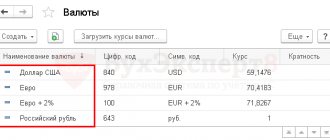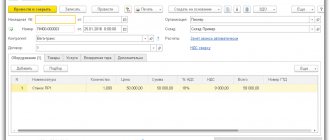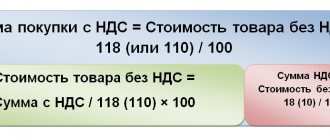When concluding a contract with a Russian organization, the director wants to tie the cost of the contract to the dollar or euro exchange rate, or even fix the exchange rate in order to insure himself against its fluctuations. In this case, the accountant must remember that this will require additional study of the legislation, because it is necessary to correctly reflect these transactions in accounting and tax accounting and correctly determine the base for VAT and income tax. Indeed, in some cases they will differ.
So, the terms of the contract may stipulate that the price of the contract is a conventional monetary unit, dollar or euro, subject to conversion into rubles on the date of payment and tied to the official exchange rate or another rate fixed in the contract. This allows us to do paragraph 2 of Article 317 of the Civil Code of the Russian Federation.
The ruble exchange rate is fixed in the contract
Let's consider a situation where the ruble exchange rate in the contract is not specified as the official rate of the Central Bank of the Russian Federation, but is fixed
somehow differently - with a certain value, or is set, for example, as the rate of the Central Bank of the Russian Federation + 2%. What will happen to the tax base for value added tax (VAT) and income tax?
VALUE ADDED TAX
In this case, everything depends on the date of payment and the date of fulfillment of obligations under the contract. Therefore, we will consider 3 options for the development of events. But first, let’s highlight the main legislative norms relating to VAT calculations in conventional units, dollars and euros.
Clause 1 of Article 167 of the Tax Code of the Russian Federation and clause 14 of Article 167 of the Tax Code of the Russian Federation.
Determines the moment of the tax base. It turns out that in our situation this is the earliest date: receipt of advance payment, or provision of a service (shipment of goods). Moreover, if the moment of determining the tax base is the date of payment, then on the date of shipment, on account of the previously received payment, the moment of determining the tax base also arises.
Clause 4 of Article 153 of the Tax Code of the Russian Federation.
Gives us the right to consider the moment of determining the tax base for VAT the day of shipment of goods, while when determining the tax base, the conventional monetary unit is recalculated into rubles at the rate of the Central Bank of the Russian Federation on the date of shipment of goods. Upon subsequent payment, the tax base will not be adjusted, and the resulting differences will have to be attributed to non-operating income or expenses.
These are the main legislative norms on which we rely. In addition, we mention the Letter of the Ministry of Finance dated 07/06/2012 No. 03-07-15/70, which should be used in the work and brought to the attention of taxpayers and tax authorities. The main essence of the letter: the received full prepayment (100%) gives the right not to recalculate the tax base for VAT at the rate of the Central Bank of the Russian Federation on the day of shipment of the goods.
All other letters from the Ministry of Finance and tax authorities devoted to this issue do not contain legal norms and are not addressed to a wide range of taxpayers, and therefore cannot be used in our conclusions.
1. We have received 100% prepayment to the settlement account for the future shipment of goods (performance of work, provision of services).
Using the Letter of the Ministry of Finance dated July 6, 2012 No. 03-07-15/70, we can conclude that upon receipt of 100% prepayment, we can use As a tax base for VAT, our fixed rate established by the agreement
, on the date of payment.
An example of VAT calculation with 100% prepayment.
A contract for the provision of services has been concluded. The cost of services is 1000 dollars, while the ruble exchange rate against the dollar is set at 54 rubles per 1 dollar. The contract provides for 100% prepayment. On the date of payment, the exchange rate of the Central Bank of the Russian Federation was 59 rubles per 1 dollar.
The customer pays 100% of the cost of the service in the amount of $1,000 at the rate of 54 rubles per $1.
The contractor receives 54,000 rubles into the account. VAT in the amount of 54,000*18/118=8,237 rubles will be charged on the prepayment amount. The cost of services provided after receiving full prepayment will no longer change for VAT purposes. The VAT amount will be fixed and on the date of service provision will remain at the level of 8,237 rubles. 2. Partial payment has been received to the bank account for the future shipment of goods (performance of work, provision of services).
If partial payment is received, then for the purposes of calculating VAT it is necessary to use only the official exchange rate of the Central Bank of the Russian Federation
and calculate VAT on the date of payment at the official rate, despite the fixed rate stipulated in the contract. At the time of provision of the service, the tax base will be determined for the unpaid part of the service at the rate on the date of provision of the service, and the prepaid part of the service, for the purpose of calculating VAT, has already been recorded as an advance payment.
Example of VAT calculation for partial payment
A contract for the provision of services has been concluded. The cost of services is $1,000, while the ruble/dollar exchange rate is fixed in the contract at 54 rubles per $1. The contract provides for 50% prepayment. On the date of prepayment, the official exchange rate of the Central Bank of the Russian Federation was 59 rubles per 1 dollar. On the date of service provision, the official exchange rate of the Central Bank of the Russian Federation is 60 rubles per dollar. On the date of subsequent payment for services, the official exchange rate of the Central Bank of the Russian Federation is 62 rubles per dollar.
The customer pays 50% of the cost of the service in the amount of 500 dollars at the rate of 54 rubles per 1 dollar (the rate fixed in the contract). The contractor receives 54*500=27,000 rubles into the account. But, for the purposes of calculating VAT, the tax base will be calculated from the cost of 500 dollars multiplied by the official exchange rate of the Central Bank of the Russian Federation
59 rubles/dollars, i.e. from the amount of 29,500 rubles. VAT in the amount of 4,500 rubles will be charged on the prepayment amount.
At the time of service provision, the official exchange rate of the Central Bank dollar is 60 rubles and the balance of our unpaid amount is 500 dollars. For the purposes of calculating VAT, it is necessary to take the official exchange rate of the Central Bank on the date of provision of the service
, therefore, the tax base for the purposes of calculating VAT will be 60*500=30,000 rubles and VAT on this cost will be 4,576 rubles.
The customer will pay at the rate fixed in the contract, i.e. 54 rubles per dollar, and an amount of 27,000 rubles will be credited to the current account. When paying after the service is provided, VAT will not be recalculated
on the date of payment 62 rubles/dollar, its amount is calculated
at the official exchange rate of the Central Bank of the Russian Federation on the date of service provision - 60 rubles ./Doll.
and will amount to 4576 rubles.
3. The goods are shipped in full (work completed, service provided) and only after that payment is received.
In this case, the rule of paragraph 4 of Article 153 of the Tax Code of the Russian Federation applies. VAT will be calculated on the date of sale of goods (rendering of services) at the official rate of the Central Bank of the Russian Federation
and its amount will not change in the future.
An example of VAT calculation for payment after shipment.
A contract for the provision of services has been concluded.
The cost of services is $1,000, while the ruble to dollar exchange rate is fixed in the contract at 54 rubles per $1. The contract provides for postpayment. On the date of service provision, the exchange rate of the Central Bank of the Russian Federation was 59 rubles per 1 dollar. On the date of subsequent payment for services, 62 rubles per dollar. At the time of provision of the service, VAT will be calculated on the amount of 59,000 rubles in the amount of 9,000 rubles, based precisely on the official exchange rate of the Central Bank, although the act in rubles will be issued in the amount of 54,000 rubles, precisely at a fixed rate. This tax amount will not change in the future, upon receipt of postpayment. INCOME TAX
Clause 8 of Article 271 of the Tax Code of the Russian Federation. We calculate income on the date of service provision
(shipment of goods, performance of work)
at the rate specified in the contract
.
If the company received an advance, then the amount of proceeds from the sale is determined at the official rate established by the Central Bank of the Russian Federation on the date of receipt of the advance
or the rate fixed in the contract, depending on which rate is linked to in the contract.
Euro invoice - sample
Payment of travel expenses is made within _____ banking days from the date of receipt of the invoice from the Supplier, but not earlier than the completion of the relevant work.
6. TRANSFER OF OWNERSHIP AND RISKS
6.1. The risk of accidental loss or damage to the goods is borne by the owner of the Equipment in accordance with the current civil legislation of Russia.
6.2. Ownership of the Equipment passes to the Buyer upon receipt of the amount specified in clause 2.1 of this agreement into the Supplier's bank account.
7. ACCEPTANCE
7.1. The quality of the supplied Equipment must be confirmed by quality certificates, which the Supplier transfers to the Buyer for each batch of Equipment.
7.2. The Supplier guarantees the quality and reliability of the supplied Equipment. If Equipment is supplied of inadequate quality, the Buyer has the right, within ____ (________) days from the moment the defect is discovered, to make a claim to the Supplier regarding the quality of the Equipment.
7.3. A claim regarding the quality of the Equipment is made by drawing up a complaint report with the participation of a representative of the Supplier.
7.4. The procedure for returning and replacing Equipment of inadequate quality is determined by additional agreement of the parties.
7.5. The quantity and range of Equipment must comply with the Specifications, which are an integral part of this agreement.
7.6. Upon acceptance and transfer of Equipment, the parties draw up an act signed by authorized representatives of both parties to the agreement.
8. RESPONSIBILITY OF THE PARTIES
8.1. For failure to fulfill or improper fulfillment of obligations under this agreement, the parties are liable in accordance with the current legislation of the Russian Federation.
8.2. In case of delay in delivery of Equipment due to the fault of the Supplier, the latter shall pay the Buyer a penalty in the amount of __% of the cost of the Equipment not delivered under the contract for each day of delay.
8.3. Payment of the penalty does not relieve the Supplier from fulfilling its obligations in kind.
8.4. The parties are released from liability for failure to fulfill obligations under the contract if it was the result of force majeure circumstances, namely: natural disasters, military operations, blockades, bans on exports and imports. In these cases, the deadlines for fulfilling obligations under the contract are postponed in proportion to the duration of these circumstances.
8.5. The party for which it has become impossible to fulfill obligations under the contract must immediately, but no later than ___ days from the moment of their occurrence and termination, inform the other party in writing (in the original, by fax, by e-mail) about the existence and termination of the circumstances that prevented fulfillment of contractual obligations. Failure to notify or untimely notification of the occurrence of these circumstances deprives the parties of the right to refer to them. The presence of force majeure circumstances must be confirmed by certification of the authorities authorized to issue the relevant certificates at the locations of the Supplier and the Buyer.
8.6. If these circumstances persist for more than two months, then each party has the right to withdraw from the contract and in this case neither party has the right to demand compensation for losses from the other party.
9. DISPUTE RESOLUTION PROCEDURE
9.1. If the parties have any disputes under this agreement, the Supplier and the Buyer undertake to take all measures to resolve them through negotiations.
9.2. If the parties are unable to reach an agreed resolution of controversial issues, all disputes will be referred to the Arbitration Court of _________.
10. TERM OF THE AGREEMENT
10.1. This agreement comes into force from the moment it is signed and is valid until the parties fully fulfill their obligations under the agreement.
10.2. The contract may be terminated in cases provided for by the current legislation of the Russian Federation.
11. FINAL PROVISIONS
11.1. This agreement is drawn up in two copies having equal legal force, one copy for each of the parties.
11.2. All Annexes to this agreement are an integral part of it.
11.3. Any changes and/or additions to this agreement will only be valid in writing, signed by both parties. Neither party has the right to transfer its rights and/or obligations under this agreement to a third party without the written consent of the other party.
11.4. From the moment of signing this agreement, all preliminary agreements, negotiations and/or correspondence between the parties in connection with this agreement become invalid.
12. ADDRESSES AND BANK DETAILS OF THE PARTIES
Provider: ______________________________________________________________________________________________________________________________________________________________________________________.
Buyer: _____________________________________________________________________________________________________________________________________________________________________________________.
SIGNATURES OF THE PARTIES:
Supplier: Buyer:
_____________/______________ ______________/____________
M.P. M.P.
The ruble exchange rate in the agreement is tied to the official exchange rate of the Central Bank of the Russian Federation
Let's consider a situation where the rate in the contract is tied to the official rate of the Central Bank of the Russian Federation. In this case, everything is simple: the exchange rate is taken by the official Central Bank of the Russian Federation on the date of prepayment in the case of prepayment, on the date of shipment in the case of postpayment:
- with 100% prepayment, VAT and income tax are calculated at the rate of the Central Bank of the Russian Federation on the date of prepayment;
- in case of partial payment, VAT and profit tax on prepayment are calculated at the rate of the Central Bank of the Russian Federation on the date of prepayment, VAT and profit tax on postpayment - at the rate of the Central Bank of the Russian Federation on the date of shipment (performance of work, provision of services);
- for postpayment - VAT and income tax on postpayment - at the rate of the Central Bank of the Russian Federation on the date of shipment (performance of work, provision of services).
Calculations in USD Are they coming back?
During the period of depreciation of foreign exchange rates, Russian entrepreneurs practically lost interest in conventional units. But since the fourth quarter of last year, due to the rapid growth in the value of the dollar and euro, many companies have changed their approach to pricing, linking it with the official exchange rates of these currencies. So, calculations in y. e. are returning.
The rise in dollar and euro exchange rates forces many companies to issue invoices in conventional monetary units. Although bills are paid in rubles. Accountants of such organizations inevitably have questions: how to compile a “primary statement”, reflect transactions on accounting accounts, calculate taxes, and prepare reports? Our article will help you figure this out.
Documents to open a foreign currency account
If an individual entrepreneur opens a foreign currency account in the same bank in which he has a ruble account, then he fills out an application and signs an agreement. The bank already has the remaining documents.
When an entrepreneur opens a foreign currency account in another bank, he brings a set of documents:
- passport;
- certificate of state registration (OGRIP);
- tax registration certificate;
- extract from the State Register of Entrepreneurs (USRIP).
Examples of purchases in foreign currency
Most purchases are carried out by customers at the federal level - ministries, departments, state corporations, research centers. For example, the Ministry of Defense purchases freight forwarding services, and many state-level corporations purchase software, equipment or specialized machines. The Ministry of Foreign Affairs publishes orders in foreign currency to support the activities of embassies in other countries.
Currency clause, what are they?
Depending on the interests pursued by the parties to foreign economic relations, the following types of currency clauses used in contracts are distinguished:
- Indirect and direct clauses. An indirect currency clause involves conditions under which the cost of goods is stated in one of the common international stable currencies, and payments under the contract are made in the currency of one of the parties. Direct currency clause in the contract, a sample of which implies the same currency of price and payment;
- Unilateral and bilateral reservations. With unilateral clauses, only one of the parties to the concluded contract is insured against possible losses; with bilateral clauses, each party to the contract is protected from possible risks;
- Other Disclaimers. Special clauses applied, if necessary, on an individual basis by agreement of the parties to the contract. Indexation clauses (linked to a price index), multicurrency clauses (correlation with a basket of currencies or SDRs) and gold clauses (linked to the price of gold), as well as bank insurance for currency risks (hedging) are considered quite common.
What is a currency clause?
A currency clause is one of the terms in an international commercial contract that provides protection to the parties to the contract from the inevitable risk of exchange rate fluctuations. When concluding a foreign trade agreement, especially for a long period, a certain clause is added to the text of the document, which ties the currency of cost or payment to a currency with a relatively stable exchange rate. Thus, the parties to the contract minimize the risk of loss in the event of an unfavorable change in the exchange rate of the currencies used for sale or purchase.
Features of tax accounting
In tax accounting, the term “exchange difference” is applied to transactions that are payable in foreign currency. And for ruble payments for obligations in conventional units, the concept of “total difference” is used (clause 11.1 of Article 250, clause 5.1 of clause 1 of Article 265 of the Tax Code of the Russian Federation). Amount differences arise if the amount of obligations and claims incurred as of the date of sale (recording) of goods (work, services), property rights does not correspond to the actual amount received (paid) in rubles. Unlike exchange rate differences at the end of the reporting period, amount differences are not revealed.
In tax accounting, amount differences are attributed to non-operating income and non-operating expenses, and are recognized at the time of payment (clause 7 of article 271, clause 9 of article 272 of the Tax Code of the Russian Federation).
Amount differences are not taken into account if taxation is based on the cash principle of accounting for income and expenses (clause 5 of Article 273 of the Tax Code of the Russian Federation). Accordingly, they are not recognized as part of income and expenses by simplified taxpayers (clause 3 of Article 346.17 of the Tax Code of the Russian Federation).
VAT recalculations due to exchange rate differences are not reflected in the tax accounting of the seller and the buyer (clause 1 of article 248, clause 19 of article 270 of the Tax Code of the Russian Federation). A different approach to the recognition of income and expenses between accounting and tax accounting will inevitably give rise to temporary and permanent differences. But that is another story.
E. Dirkova
Auditor,
CEO
LLC "BUSINESS ACCOUNTANT"
May 4, 2018
Fines for individual entrepreneurs when passing exchange control
The main pitfalls of a foreign exchange account are fines at the stage of currency control. Individual entrepreneurs pay them for delays, mistakes and dishonesty of counterparties.
For being late, an individual entrepreneur pays 500–5000 rubles. The greater the delay, the greater the fine.
If the counterparty violates payment deadlines or does not pay the full amount, the individual entrepreneur pays 1/150 of the Central Bank refinancing rate for each day of delay or 75–100% of the amount under the agreement with the foreign partner.
For errors in documents, entrepreneurs pay:
- 4000–5000 rubles for the first mistake;
- 10,000 rubles for a repeated mistake.
For example, an entrepreneur in documents named the counterparty “Bournemouth” instead of “Bournemouth”. The bank will return the documents, and the individual entrepreneur will pay 4,000–5,000 rubles.
In order not to receive fines, entrepreneurs monitor in their personal bank account when payment is received, set payment deadlines with a reserve, or work on an advance payment basis.
Table. Fragment of the business transactions journal of Rotor LLC (loan settlements)
| date | Debit | Credit | Contents of operation | Amount, rub. | Exchange rate of the Central Bank of the Russian Federation, euro/rub. | |
| 19.01.2009 | 51 | 66 | Borrowed funds were received in an amount equivalent to EUR 10,000 (EUR 10,000 x EUR 43.0800/RUB) | 430 800 | 43,0800 | |
| 31.01.2009 | 91.2 | 66 | Reflected positive exchange rate difference from revaluation of the obligation to the lender | 25 836 | 45,6636 | |
| 07.02.2009 | 91.2 | 66 | Reflected positive exchange rate difference from revaluation of the obligation to the lender | 8 152 | 46,4788 | |
| 66 | 51 | The debt to the lender has been repaid (10,000 euros x 46.4788 euros/rub.) | 464 788 | |||
As can be seen from the table, upon completion of the transaction, account 66 “Settlements for short-term loans and borrowings” has no balance. Thus, in accordance with the actual agreement, the settlements of the parties are completed.
If the exchange rate falls, the accountant will apply reverse posting:
Debit 66 Credit 91.1
- The liability was adjusted for negative exchange rate differences.
Is it permissible to set wages in conventional units in employment contracts? This issue does not have a clear solution. Rostrud specialists pointed out that in the context of a depreciating currency, such an approach violates the interests of workers (Letter dated October 10, 2006.










